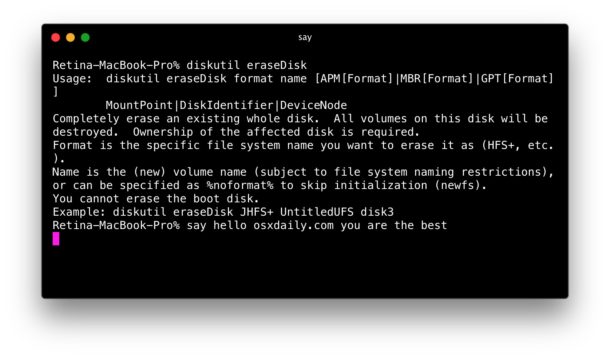He Ls /dev/disk? Command Returns the Hardware Information for the Host System.

Some Mac users may crave the ability to erase a disk or erase a difficult drive from the control line on Mac OS, a task which is typically performed through the Disk Utility application from the GUI. The command line approach to disk erasure in macOS is a bit unlike and information technology requires precise syntax to insure that you are erasing the proper disk, making this method of erasing any disk only appropriate for advanced Mac users.
This guide will walk through how to erase and format an entire target disk using exclusively the control line on any Mac using macOS or Mac OS X. You can choose whatsoever mutual file system format the disk to after information technology has been erased, including ExFAT, FAT32, HFS+, or JHFS+.
Notice that this is aiming to erase the unabridged disk from the control line hither, this is non just erasing a book or sectionalization on the target deejay. The entire target deejay is erased, all data on the target disk is destroyed using this approach, with no volumes or partitions or any information remaining. Do not misunderstand that, otherwise you volition inevitably permanently lose data when it is erased and destroyed. Call back the command line is unforgiving, if you lot are non comfortable at the command line it would be much more advisable to erase and format a disk using Deejay Utility in the standard interface of Mac Bone X.
How to Erase a Disk from the Command Line of Mac Os
To get started, you'll demand to launch the Last awarding on the Mac which gives access to the command line. It tin can be constitute with Spotlight, Launchpad, or in the /Applications/Utilities/ folder.
To erase a deejay from the command line on the Mac, we'll utilise the familiar "diskutil" command with the eraseDisk verb and other advisable flags to specify options for how we want to erase the disk, and to identify which disk is to be erased.
The basic syntax for erasing a disk from the command line in macOS is every bit follows:
diskutil eraseDisk FILE_SYSTEM DISK_NAME DISK_IDENTIFIER
For case, let's say you have used "diskutil list" to show all of mounted drives on a Mac from the command line, and you lot take determined the appropriate bulldoze to erase is identified as /dev/disk6s2, you desire the deejay proper name to be "Emptied" and you desire the new disk file system format type to be Mac OS Extended Journaled (JHFS+), the syntax would be the following:
diskutil eraseDisk JHFS+ Emptied /dev/disk6s2
It is absolutely disquisitional that you utilize proper syntax when identifying the deejay to erase. Improper identification may lead to erasing the wrong deejay, permanently destroying any data on it. Exercise not screw this up. If y'all are unsure, you lot tin find the disk ID node with "diskutil info "DISK NAME" |grep Device".
For some quick reference, here are a few examples of diverse disk erasure methods for dissimilar file system format types. As always, be sure you change the disk node as appropriate for your deejay.
Formatting a Disk to Mac Os Extended Journaled (JHFS+) from Terminal in Mac OS Ten
diskutil eraseDisk JHFS+ DiskName /dev/DiskNodeID
Formatting a Disk to Mac OS Extended (HFS+) from Terminal in Mac Bone 10
diskutil eraseDisk HFS+ DiskName /dev/DiskNodeID
Formatting a Disk to MS-DOS fat32 from the Control Line in Mac OS X
diskutil eraseDisk FAT32 DiskNameGoesHere /dev/DiskNodeIDHere
Formatting a Disk to ExFAT from the Command Line in Mac Bone X
diskutil eraseDisk ExFAT DiskName /dev/DiskNodeID
Over again, any of these commands erase the unabridged target disk and obliterates any data on it.
Users who would like additional details or information about the other options available including MBR and GPT settings can query the man page with "human diskutil" and searching for "eraseDisk", or execute the command with no specifics like and so:
diskutil eraseDisk
Usage: diskutil eraseDisk format name [APM[Format]|MBR[Format]|GPT[Format]]
MountPoint|DiskIdentifier|DeviceNode
Completely erase an existing whole disk. All volumes on this disk will be
destroyed. Buying of the afflicted disk is required.
Format is the specific file system proper name you want to erase it equally (HFS+, etc.).
Name is the (new) book name (subject area to file system naming restrictions),
or can exist specified equally %noformat% to skip initialization (newfs).
You cannot erase the boot disk.
Example: diskutil eraseDisk JHFS+ UntitledUFS disk3
Finally, it's worth mentioning that if yous want to erase the currently booted disk from the control line from this method, you'd want to do then from a kick deejay or from recovery style. Single User Fashion alone is not sufficient to erase the actively booted operating system.
0 Response to "He Ls /dev/disk? Command Returns the Hardware Information for the Host System."
Post a Comment